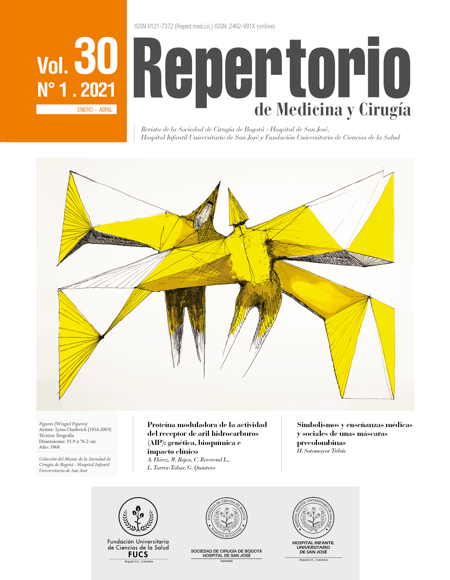Simbolismos y enseñanzas médicas y sociales de unas máscaras precolombinas
Symbolisms and medical and social teachings of some pre-columbian masks
Cómo citar
Descargar cita
Esta obra está bajo una licencia internacional Creative Commons Atribución-NoComercial-CompartirIgual 4.0.
Mostrar biografía de los autores
Se presentan 4 máscaras precolombinas, tres de las cuales son ecuatorianas y una colombiana. Las primeras son de cerámica y se adscriben a la cultura Jama-Coaque y la tercera de concha Spondylus prínceps no tiene adscripción a ninguna en particular del Ecuador prehispánico, por no existir un estudio sistemático en Ecuador sobre la relación de esas máscaras con sus culturas costeras, la colombiana es de cobre. La primera de cerámica ecuatoriana por su tamaño, peso y elementos agregados – un material blanco que simula los dientes, tres piedras verdes que parecen los ojos y una incrustación sublabial, un bezote – hacen pensar en una máscara mortuoria de un personaje de poder y alto estatus social; la segunda de cerámica por presentar dieciséis nódulos faciales remite al observador a la llamada verruga peruana o bartonelosis, la tercera ecuatoriana fue elaborada posiblemente como un elemento votivo o de ofrenda para exhibir poder o invocar fuerza o protección dado el carácter de gran valor simbólico de esa concha roja. La máscara de cobre del Cauca medio o Quimbaya, en razón a su material, peso y color, con bastante probabilidad fue usada como adorno colocado sobre el pecho del personaje poderoso o de elevado estatus. Se compara la máscara con bartonelosis con otras dos que el autor ya había documentado, la de concha con otra del mismo tipo de material, la máscara de cobre con una pequeña de piedra jadeíta se referencia con una calavera enmascarada que el autor tuvo la oportunidad de estudiar hace varios años. Se concluye sugiriendo los usos tradicionalmente asignados a las máscaras: festivos, mortuorios y como adornos corporales para resaltar el poder de quien las exhibe. Las máscaras con la erupción tipo nódulos debieron jugar un papel similar a las estatuillas en cerámica y piedra que representan patologías con tanto realismo en el arte prehispánico, pudiendo ser una forma de enseñar, dentro de un pensamiento médico empírico analógico, como lo son los moldes en cera, las fotografías, los dibujos y pinturas en la medicina moderna basada en un pensamiento empírico analítico.
Visitas del artículo 969 | Visitas PDF 760
Descargas
1. Sotomayor Tribín HA. A propósito de la Bartonelosis en una Máscara Ecuatoriana Precolombina. Revista Medicina. 1994;16(2):28-9.
2. Sotomayor Tribín HA, Correal Urrego G. Las calaveras enmascaradas de las momias Yuko-Yukpa (Motilones). Revista de la Academia Colombiana de Ciencias Exactas, Fisicas y Naturales. 2003;27(102):5-14.
3. Sotomayor Tribín HA. Aspectos históricos y geográficos de algunas enfermedades importantes en Colombia. Bogotá: Universidad Militar Nueva Granada; 2012.
4. Chávez Mendoza Á. Máscara precolombina. Bogotá: Ediciones Zazacuabi; 1977.
5. Restrepo De León A. Los rostros de la mar. Bogotá: Inédito; 2017.
6. Quinatoa Cotacachi E. Representaciones ancestrales y colores del cosmos: diseños de platos del Carchi. Colombia: Ministerio de Cultura y Patrimonio; 2013.
7. Museo Nacional del Banco Central del Ecuador. Jama-Coaque en la Guía de la sala de arqueología. Quito: Banco Central del Ecuador; 2001. p. 62.
8. Botero CI. Museo del Oro. Bogotá: Banco de la República; 2008. p. 91-103.
9. de León C. La crónica del Perú. Madrid: Historia 16; 1984.
10. Garcilaso de la Vega I. Historia General del Perú. In: Oviedo JM, editor. La edad del oro Crónicas y testimonios de la conquista del Perú. Barcelona: Tusquet; 1986. p. 205.
11. Flores E, Cevallos L, Burstein Z. Historia de la dermatología en Perú. In: Galimberti R, Pierini A, Cervini A, editors. Historia de la Dermatología Latinoamericana. Toulouse: Ed Privat; 2007. p. 307-64.
12. Sotomayor Tribín HA. Memorias del II Congreso Peruano de Genética y XVI Latinoamericano de Genética. Descripción de enfermedades genéticas en cerámicas prehispánicas de la Cultura Tumaco - La Tolita. Lima Perú1989.
13. Sotomayor Tribín HA. Enfermedades en el arte prehispanico colombiano. Boletín Museo del Oro. 1991;29:63-73.
14. Sotomayor Tribín HA. Arte tumaco y medicina indígena prehispánica en Colombia. Pediatría. 1991;25(1).
15. Sotomayor Tribín HA. Arte indígena prehispánico colombiano y enfermedades. Pediatría. 1991;26(1).
16. Sotomayor Tribin HA. Iconografía del dolor, la enfermedad y la Muerte en la Cultura Precolombina de Tumaco. La Tolit. Revista Medicina. 1992;14(4):35-7.
17. Sotomayor Tribín HA. Arqueomedicina de Colombia Prehispánica. Bogotá: Cafam-Comisión V Centenario; 1992.
18. Sotomayor Tribín HA. Enfermedades y símbolos de poder y trascendencia en cerámicas prehispánicas colombianas. Pediatría. 1993;28:63-73.
19. Sotomayor Tribín HA, Correal Urrego G. Iconografía de patologías en la colección de orfebrería del Museo del Oro del Banco de la República. Boletín Museo del Oro. 1995(38-39):172-5.
20. Sotomayor Tribín HA. Arqueomedicina de Colombia prehispánica. Bogotá: Edifarni; 1999.
21. Sotomayor Tribín HA, Cuéllar-Montoya Z. Aproximaciones a la paleopatología en América Latina. Colombia: Academia Nacional de Medicina de Colombia; 2007.
22. Sotomayor Tribín HA. Enano y gigantes en mitologías indígenas y la arqueología de Colombia. Repert Med Cir. 2007;16(2):96-104. doi: 10.31260/REPERTMEDCIR.V16.N2.2007.466
23. Sotomayor Tribín HA. Enanismo: Representaciones artísticas en Amŕeica prehispánica y otras sociedades. Repert Med Cir. 2014;23(4):299-313. doi: 10.31260/REPERTMEDCIR.V23.N4.2014.702
24. Sotomayor Tribín HA. Pensamiento analógico mítico en la interpretación del arte prehispánico de interés para la arqueomedicina y la paleopatología. Repert Med Cir. 2016;2(1):59-71. doi: 10.1016/j.reper.2016.02.013













